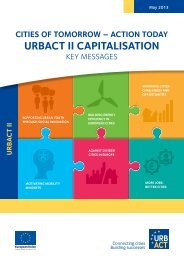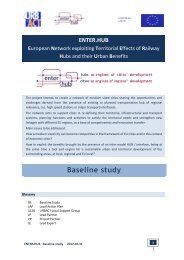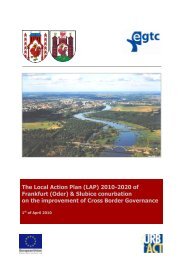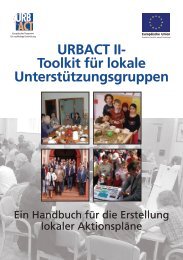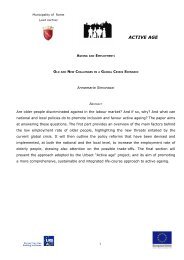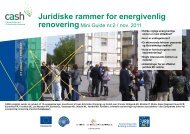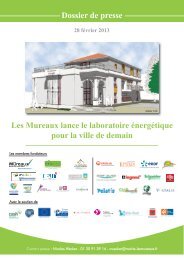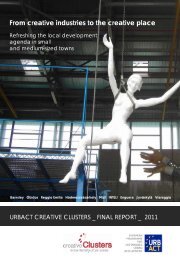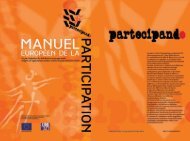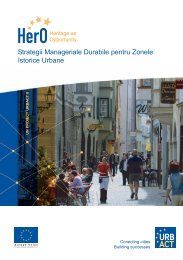Lille Métropole Local Action Plan - Urbact
Lille Métropole Local Action Plan - Urbact
Lille Métropole Local Action Plan - Urbact
You also want an ePaper? Increase the reach of your titles
YUMPU automatically turns print PDFs into web optimized ePapers that Google loves.
<strong>Lille</strong> <strong>Métropole</strong> <strong>Local</strong> <strong>Action</strong> <strong>Plan</strong><br />
© V. Le Cigne, <strong>Lille</strong> <strong>Métropole</strong>
TABLE OF CONTENT<br />
INTRODUCTION………………………………………………………………………………………………………………………. 2<br />
1) The <strong>Local</strong> Support Group and its involvement in the elaboration of the <strong>Local</strong> <strong>Action</strong> <strong>Plan</strong><br />
……………………………………………………………………………………………………………………………………. 4<br />
2) Expectations and achieved results……………………………………………………………………………….. 5<br />
I. Content of the local action plan……………………………………………………………………………. 6<br />
1) « Leadership » issues…………………………………………………………………………………………………… 6<br />
a. Starting situation……………………………………………………………………………………………………… 6<br />
b. Link with regional, national, and European levels…………………………………………………… 12<br />
c. Good practices experimented by the cross-border conurbation…………………………….. 13<br />
d. Problems to be solved…………………………….. ……………………………………………………………..15<br />
e. Solutions to be developed……………………………………………………………………………………… 17<br />
f. Recommendations at national and European levels………………………..………………………17<br />
2) Community issues……………………………………………………………………………………………………… 17<br />
a. Starting situation……………………………………………………………………………………………………. 17<br />
b. Good practices experimented by the cross-border conurbation……………………………. 18<br />
c. Problems to be solved……………………………………………………………………………………………. 19<br />
d. Solutions to be developed……………………………………………………………………………………… 19<br />
e. Recommendations at national and European levels………………………………………………. 20<br />
II. The activities programme…………………………………………………………………………………… 20<br />
III. Network and communication activities – Perspectives……………………………………….. 25<br />
1) Contacts with regional, national and European administrations………………………………… 25<br />
2) Contacts with other cross-border conurbations…………………………………………………………. 26<br />
3) Description of activities and documents…………………………………………………………………….. 27<br />
ORGANIZATION SCHEME………………………………………………………………………………………………………. 30<br />
1
INTRODUCTION<br />
The “EGTC” URBACT project (Expertising Governance for Transfrontier Conurbations) is<br />
a European working group co-financed by the URBACT II programme (2007-2013). This<br />
programme aims to encourage the sharing of experiences between European cities and to<br />
disseminate knowledge on sustainable urban development throughout Europe.<br />
The project is led by Mission Opérationnelle Transfrontalière (MOT); it involves six crossborder<br />
conurbations in Europe: <strong>Lille</strong> Metropole for the Eurometropole <strong>Lille</strong>-Kortrijk-Tournai<br />
(F/BE), Basel for the Trinational Eurodistrict Basel (F/DE/CH), Esztergom for the Ister-Granum<br />
EGTC (HU/SK), Chaves for the conurbation Chaves-Verin (ES/PT), Slubice for the Frankfurt<br />
(Oder)-Slubice conurbation (DE/PL), and Strasbourg for the Eurodistrict Strasbourg-Ortenau<br />
(F/DE).<br />
2
The partners aimed to:<br />
- improve their governance models by exchanging experiences, with the support of<br />
the Lead Expert,<br />
- capitalize best practices, spread models of governance throughout Europe and,<br />
- promote cross-border agglomerations at national and European levels.<br />
The new opportunities provided by the European Grouping of Territorial Cooperation,<br />
the European instrument (EC Regulation 1082/2006), whose use is still under<br />
experimentation, constituted an interesting case study. The first two European Groupings of<br />
Territorial Cooperation in Europe were involved in the “EGTC” URBACT project and an EGTC<br />
was established during the project.<br />
By “cross-border governance”, the project partners have agreed to deal with the<br />
following two major themes:<br />
- How can public leaders and cross-border organizations frame and implement<br />
efficient policies (“Leadership” issues)?<br />
The way a cross-border conurbation is managed on a technical, political, legal, as well as<br />
financial point of view. The main question resulting from this issue is the one of designing<br />
and implementing cross-border urban strategies and concrete projects by involving all<br />
relevant public stakeholders on both sides of border.<br />
- How can the involvement of the civil society guarantee the legitimacy of cross-border<br />
agglomeration policies (“Community” issues)?<br />
The way a cross-border conurbation earns its legitimacy to intervene above national<br />
borders, through the development of mobilizing projects aimed at citizens, through the<br />
development of services dedicated to the citizens, through the emergence of cross-border<br />
Medias which enable a dialogue with the inhabitants, and through the creation of<br />
participative democracy mechanisms. The main question related to this issue is the one of<br />
building efficient and legitimate partnerships able to address cross-border territorial<br />
cohesion issues.<br />
In order to make sure that the URBACT projects lead to concrete and realistic outcomes, the<br />
URBACT II programme requires specific results from the URBACT project partners:<br />
• Each partner realizes a <strong>Local</strong> <strong>Action</strong> <strong>Plan</strong>, which identifies the measures and actions<br />
which will be implemented in order to improve the running policies. It aims to<br />
3
provide pragmatic, precise solutions based on the results of the transnational<br />
exchanges. It is jointly produced with the <strong>Local</strong> Support Group (link) on the local level<br />
and with all the project partners on a transnational level.<br />
• All URBACT project partners commit to establishing and leading an URBACT <strong>Local</strong><br />
Support Group to make sure that exchanges have an impact on local practices and<br />
policies. This group assembles the main interested parties and local actors concerned<br />
by the project topic and the issues the partner is looking to resolve; the groups<br />
include local elected officials, representatives of various local administrative<br />
departments, representatives of residents/users, etc.<br />
URBACT <strong>Local</strong> Support Groups contribute to implementing transnational activities<br />
(production/approval of case studies, for example) and producing the <strong>Local</strong> <strong>Action</strong><br />
<strong>Plan</strong> that each partner has to produce as the result of participation in the URBACT II<br />
programme.<br />
For more information: http://urbact.eu<br />
1) The local Support group and its involvement in the<br />
elaboration of the <strong>Local</strong> <strong>Action</strong> <strong>Plan</strong><br />
- Composition of the <strong>Local</strong> Support Group :<br />
In this period of first steps for the EGTC (European Grouping of Territorial Cooperation),<br />
the partnership focuses on the launching of the structure. It had been decided that the<br />
technical support group of the EGTC would bring together technical representatives of the<br />
14 members of the EGTC. In fact no other group could have the legitimacy of defining a<br />
strategy.<br />
Normaly they had to meet once a month in order to work on the administrative and<br />
technical aspects, and to define the short and medium term strategy. As <strong>Lille</strong> <strong>Métropole</strong><br />
Communauté Urbaine is one of the 14 members of the EGTC, and is the partner of the<br />
URBACT-EGTC network, it had to « translate » the technical group’s strategy into the local<br />
action plan, and on the other hand make sure that the technical group was aware of the<br />
development of that plan.<br />
- Involvement in the elaboration of the <strong>Local</strong> <strong>Action</strong> <strong>Plan</strong> :<br />
4
On January 26 th 2009, <strong>Lille</strong> <strong>Métropole</strong> asked the Lead Expert of the EGTC URBACT II<br />
project, Christian LAMOUR, his help in order to think about the URBACT EGTC project and to<br />
give a new impulse to the writing of the LAP (<strong>Local</strong> <strong>Action</strong> <strong>Plan</strong>). During a meeting with all<br />
the members of the <strong>Local</strong> Support Group it had been decided that, because of the very<br />
recent creation of the EGTC <strong>Lille</strong>-Kortrijk-Tounai and the size of <strong>Lille</strong> <strong>Métropole</strong> -which slows<br />
down the concret actions-, the LAP would be focused on general orientations which could<br />
be taken by the Eurometropole.<br />
2) Expectations and achieved results<br />
The territory of <strong>Lille</strong>-Kortrijk-Tournai was involved in the EGTC project through <strong>Lille</strong><br />
<strong>Métropole</strong>, in order to exchange with other leading crossborder territories. The key<br />
motivation, mentioned in the declaration of interests (12/02/2008), was the creation of the<br />
EGTC « Eurometropole <strong>Lille</strong>-Kortrijk-Tournai / Eurometropool <strong>Lille</strong>-Kortrijk-Tournai », the<br />
first in the EU, in January 2008. Launching the fisrt EGTC is a big challenge and a great<br />
opportunity to exchange with other territories as well.<br />
<strong>Lille</strong> <strong>Métropole</strong>, as the main financial contributor, wants to make sure that this new<br />
structure will become successful. Moreover, it was time to set up the operational<br />
organization that will enable effective development of ambitious projects within a multilevel<br />
governance framework. Concerning the URBACT EGTC project, <strong>Lille</strong> <strong>Métropole</strong><br />
expected to discuss the implementation of the EGTC regulation with other cross-border<br />
areas and thus elaborate recommendations for the creation of EGTCs elsewhere in Europe. It<br />
also expects to indentify how the EGTC could liven up the cross-border territory and run<br />
concrete projects, in particular by using Structural Funds.<br />
On the other hand <strong>Lille</strong> <strong>Métropole</strong> wanted to highlight its first successes. Being the first<br />
territory in the UE to create an EGTC and to experiment that new tool is also a matter of<br />
communication among the other European Metropolitan areas.<br />
The first results of the project for <strong>Lille</strong> <strong>Métropole</strong> were<br />
- A better knowledge of the geography of crossborder<br />
conurbations in Europe.<br />
- A better understanding of the diversity of crossborder<br />
strategies, and hence, a clearer view on its own choices.<br />
- The awareness of the need to define its role into the<br />
EGTC, to define the technical group.<br />
5
- The awareness of improving the governance of the Eurometropole (creation of the<br />
Forum…)<br />
- The chance to exchange on methods and tools to improve the governance of the crossborder<br />
conurbation, with professionals, politicians and others, towards various seminars.<br />
I. Content of the local action plan<br />
a. Starting situation<br />
1) « Leadership » issues<br />
History of the cross-border co-operation in the area.<br />
The area has always been a fertile ground for crossborder projects. The INTERREG<br />
fundings supported many projects to solve crossborder issues such as water management,<br />
transportation... A second achievement of those fundings was that their financial attractivity<br />
helped a lot of structures look for partners on the other side of the border.<br />
The different authorities developped their own crossborder strategies with some<br />
partners: the département with the provincies, <strong>Lille</strong> <strong>Métropole</strong> with the Belgian<br />
intercommunales through a common association. Since 1991, the French-Belgian<br />
metropolitan project was covered by the Cross-Border Standing Conference of Intermunicipal<br />
Organisation (COPIT). This common tool brought together <strong>Lille</strong> Métropolis Urban<br />
Community (1.1 million inhabitants) and four Belgian intermunicipal entities (700 000<br />
inhabitants).<br />
In 2002, a global reflection was launched to consider the evolution of COPIT into a<br />
cross-border structure of governance. A French-Belgian Parliamentary Working Group<br />
started trying to identify the main obstacles to effective cross-border cooperation in the <strong>Lille</strong><br />
metropolitan area, and more generally on the French-Belgian border. They also intented to<br />
define conditions of experimentation for adapted organisational patterns.<br />
The Eurometropole <strong>Lille</strong>-Kortrijk-Tournai was officially set up on January 20 th 2008 and the<br />
recruitment of the staff agency started in June 2008.<br />
Why create an EGTC ?<br />
6
Before the creation of the EGTC, on many issues the authorities weren’t successful in<br />
reaching all the relevant partners. The main reason was that, on both sides of the border,<br />
the administrative organization was very complex and the roles were not clearly defined.<br />
Moreover, a metropolis could not exist between the large metropolitan areas of north<br />
Western Europe without beeing united. So the priority tasks of the Eurometropole EGTC<br />
are :<br />
• To ensure consultation, dialogue and to encourage political debate, bringing together<br />
all institutions.<br />
• To produce cross-border consistency throughout the whole territory.<br />
• To facilitate, carry and realize projects that<br />
reflect the development strategy worked<br />
out in common.<br />
© <strong>Lille</strong> <strong>Métropole</strong><br />
• To facilate the day-to-day life of the inhabitants of the French-Belgian metropolis<br />
Which territory ?<br />
Located on the French-Belgian border<br />
and on the regional limit between Flanders<br />
and Wallonia in Belgium the Eurométropole is<br />
a major train junction. The territory of the<br />
EGTC encompasses 2 million inhabitants in a<br />
mainly urban area (arbout 575 inh/km²).<br />
There is no real geographical barrier such as a<br />
large river or mountains. In spite of the<br />
administrative division of the territory (partly<br />
reduced by the European construction)<br />
thousands of inhabitants cross the border<br />
everyday to work, study, shop, visit…<br />
7
The official Eurométropole border is permeable: as Mr Peugeot (head of the Forum)<br />
recalled during the the URBACT city lab seminar closure (12/02/2010), the stakes cannot be<br />
boiled down to a delimited border. The Eurométropole EGTC keeps that in mind and a lot of<br />
projects go past the official border.<br />
A short description of the organization<br />
(See the apendix: Eurométropole governance)<br />
The Eurométropole Governance at the beginning of the « EGTC » URBACT project<br />
The Eurométropole <strong>Lille</strong>-Kortrijk-Tournai EGTC is a formal structure and has its own<br />
statutes. All the institutional levels in France and in Belgium are involved in this cross-border<br />
cooperation process. The EGTC brings together the 14 stakeholders of the cross-border<br />
conurbation gathering all competencies:<br />
• On the French side : the State, the Région Nord-Pas-de-Calais, the Département du Nord<br />
and <strong>Lille</strong> <strong>Métropole</strong> Communauté Urbaine.<br />
8
• On the Belgian side : the federal State, the Flemish Region and Community, the Province<br />
of Western Flanders, the Leiedal intermunicipal association, the WVI intermunicipal<br />
association, the Walloon Region, the French Community of Belgium, the Province of<br />
Hainaut, the IDETA intermunicipal association, the IEG intermunicipal association.<br />
When the Eurométropole joined the URBACT project named « EGTC » there were only the<br />
political organs which are:<br />
The advisory bodies: a conference of the Mayors and Burgomasters<br />
(http://conferenceeurometropole.wordpress.com)<br />
- Which brings together all the Mayors and Burgomasters of the Eurometropole. Its<br />
purpose is to inform the Mayors and the Burgomasters on the works and projects of the<br />
EGTC and facilitate communication between them at the communal level.<br />
- The decision<br />
making organ is<br />
composed of the<br />
assembly and the Board<br />
of the Eurométropole.<br />
The assembly (which is<br />
named by the Conference<br />
of the Mayors and<br />
Burgomasters) elects the<br />
Board, the president, the<br />
3 vice-presidents, votes<br />
the annual budget and<br />
launches the recruitment<br />
of the technical team.<br />
The assembly is composed<br />
of 84 representatives:<br />
- For the French members :<br />
• 32 representatives of <strong>Lille</strong> <strong>Métropole</strong> designated by the Community Council.<br />
• 2 representatives of the State designated by the Minister of Interior and by<br />
the Minister of Foreign Affairs.<br />
• 4 representatives of the Nord-Pas-de-Calais Region designated by the<br />
Regional Council.<br />
9
• 4 representatives of the Département du Nord designated by the General<br />
Council.<br />
- For the Belgian members :<br />
• 15 representatives, localy elected, designated by a joint agreement between<br />
the intermunicipal associations of Leidal and WVI, the municipal district of<br />
Kortrijk, Leper, Roeselare and Tielt.<br />
• 15 representatives, localy elected, designated by a joint agreement between<br />
the municipal district of Mouscron-Comines, Tournai and Ath and by the<br />
municipalities of Lessines, Silly and Enghien and by the Intermunicipalities<br />
Ideta and Ieg.<br />
• 1 French speaking representative and 1 Dutch speaking representative from<br />
the Federal State designated by the Federal Government.<br />
• 4 representatives of the Region and of the Flemish community designated by<br />
the Flemish government.<br />
• 2 representatives of the Walloon Region designated by its government.<br />
• 2 representatives of the French Community of Belgium designated by its<br />
government.<br />
• 1 representative of the Province of Western Flanders designated by the<br />
Députation.<br />
• 1 representative of the Province of Hainaut designated by the Députation.<br />
The assembly is convened by its President at least once a year and can be convened if<br />
at least a quarter of its members wants a meeting. The deliberations are adopted if there<br />
are: the absolute majority of the French members, of the French speaker representatives of<br />
the Belgian members, of the Dutch speaker representatives of the Belgian members.<br />
The board is composed of 32 members:<br />
- For the French members :<br />
• 11 representatives among those of <strong>Lille</strong> <strong>Métropole</strong>.<br />
• 1 representative among those of the State.<br />
• 2 representatives among those of the Nord-Pas-de-Calais Region.<br />
• 2 representatives among those of the Département du Nord.<br />
- For the Belgian members :<br />
• 4 representatives among those designated by a joint agreement between the<br />
intermunicipal associations of Leidal and WVI, the municipal district of<br />
Kortrijk, Leper, Roeselare and Tielt.<br />
10
• 4 representatives among those designated by a joint agreement between the<br />
municipal district of Mouscron-Comines, Tournai and Ath and by the<br />
municipalities of Lessines, Silly and Enghien and by the Intermunicipalities<br />
Ideta and Ieg.<br />
• The French speaker representative and the Dutch speaker representative of<br />
the Federal State.<br />
• 2 representatives among those of the Flemish Region and community.<br />
• 1 representative among those of the Walloon Region.<br />
• 1 representative among those of the French community of Belgium.<br />
• The representative of the Province of Western Flanders.<br />
• The representative of the Province of Hainaut.<br />
The Board decisions are taken unanimously.<br />
Moreover, there was a strong wish to involve socio-economic actors and we will see,<br />
in the part about community and good practices, that the Eurométropole managed to create<br />
« the Forum » in order to answer to this need.<br />
The technical work of the Eurometropole will be ensured by a cross-border agency, which is<br />
an administrative and technical tool. As we will see further, the recruitment of this team is<br />
still in progress, the General Director has been designed the 9 th of April 2010. Waiting for the<br />
general director, a temporary management has been set up.<br />
The EGTC’s Budget.<br />
As it was written in the project sheet on 03/03/2009, the EGTC <strong>Lille</strong>-Kortrijk-Tournai<br />
has its own budget. In 2008, this first budget reached 989.000 euros, resulting from the<br />
contribution of each 14 partners, and including 245.000 euros for investments. But during<br />
this period, no investments were achieved and the operating expenses were limited (26.824<br />
euros), due to the fact that the officers of the cross border Agency were not in position.<br />
Therefore, the surplus of 963.076 euros has been affected to the budget 2009.<br />
Each partner gives an annual contribution which equals to 50% for France and 50%<br />
for Belgium. For the French partners, the State: 5%, Région: 10%, Département du Nord:<br />
10%, <strong>Lille</strong> <strong>Métropole</strong> Communauté Urbaine: 25%. Moreover, the EGTC may apply for loans.<br />
For 2010 the budget will be 1 500 000 euros.<br />
It is clear that at the moment, the actions are just at the stage of the studies. The cost<br />
of the carrying out will have to be discussed in regard to quality, appropriateness,<br />
localization of the project or the action…The objective is to define a budget adapted to the<br />
11
eal needs of the Eurométropole which correspond to the ambitions of the EGTC. The<br />
Agency will have to be careful in order to avoid overspending, and the concrete actions must<br />
be based on planning documents in order to show to the European commission that the<br />
cross border cooperation reinforces territorial cohesion… At the moment, a transfer of<br />
competences is not on the agenda.<br />
b. Link with regional, national and European levels.<br />
There are different reasons why a multi-level dialogue is required in cross-border issues in<br />
that area:<br />
- The cross-border issues always involve different actors (at least two). Hence, solving a<br />
problem requires taking the complexity into account.<br />
- Even if not all of the issues to be coped with involve the three territorial components<br />
(France, Wallonia, Flanders), the need to build a common metropolis (based on a<br />
common identity) creates that need for many projects, at least the non territorial ones.<br />
Besides, a large part of the urban area (Lys valley and Tourcoing-Mouscron-Kortrijk)<br />
crosses the three regions.<br />
- There is no symmetry. On the French-Belgian border, such as most of the borders, the<br />
different regulations and organizations often require to take more actors into account.<br />
- Sharing a common territory. The Eurométropole is one territory in almost every « hard »<br />
issue (environment, planning…). There is no major geographical difference between the<br />
different subterritories. Those issues in this territory involve the competences of many<br />
different authorities.<br />
- Dealing with soft issues. The soft issues (such as education, culture, research, tourism…)<br />
involve a lot of different actors in the area.<br />
- This area is a transit territory: large infrastructures cross the territory (train, highway,<br />
water). Some others are planned. For different reasons these infrastructures have to be<br />
taken into account :<br />
• They shape the territory and many projects on a very local scale have to be adapted<br />
to them (e.g. the Lys valley).<br />
• They are an opportunity to catch a part of the traffic (ex : the TGV station <strong>Lille</strong><br />
Europe)<br />
• They can help the territory become more competitive.<br />
12
But these infrastructures also attract the attention of the regional, national and<br />
European levels. Furthermore, in such a transit territory, preferences are sometimes given to<br />
the large infrastructures at the cost of the local networks. Besides, the local cross-border<br />
networks (<strong>Lille</strong>-Kortrijk and <strong>Lille</strong>-Tournai) are often considered as international lines by the<br />
national level even if their scale is clearly local.<br />
c. Good practices experimented by the cross-border conurbation<br />
Franco-Belgian parliamentary working group<br />
The French-Belgian Parliamentary working group was born in 2006 thanks to a very<br />
strong political consensus to improve the cross-border situation, and its work determined<br />
the setting-up of the Eurométropole. It was composed of State parliamentarians (French<br />
and Belgian), regional parliamentarians (Belgian) and a European parliamentarian.<br />
Mr Lamassoure<br />
French members<br />
Spokesperson and<br />
European deputy<br />
Mr De Clerck<br />
Belgian members<br />
Spokesperson and Flemish<br />
deputy<br />
Mr Mauroy Senator Mr Brotcorne Senator<br />
Mr Delnatte Deputy Mme Lahaye-Battheu<br />
Deputy of the House of<br />
Representatives<br />
Mr Roman Deputy Mr Bossuyt Flemish deputy<br />
Mr Vanneste Deputy Mr Crucke<br />
Deputy of the French<br />
community<br />
Mr Vercamer Deputy Mr Delannois Walloon deputy<br />
For the legal issues the aims were:<br />
- Make a census of the various projects and subjects of common cross-border interest.<br />
- Identify the main legal obstacles to effective cross-border cooperation in the <strong>Lille</strong><br />
metropolitan area, and more generally on the French-Belgian border.<br />
13
- Define conditions of experimentations for adapted organisational patterns.<br />
Seven work themes were chosen:<br />
- <strong>Plan</strong>ification and urban planning<br />
- Transports, mobility and telecommunications<br />
- Employment, taxation, profesional training, companies growth<br />
- Water and environment<br />
- Health and social issues<br />
- Education<br />
- Security<br />
The general diagnosis was :<br />
• The metropolis <strong>Lille</strong>-Kortrijk-Tournai is a very interesting cross-border area: there<br />
is no real geographical barrier, a strong history of cooperation… So the French-<br />
Belgian parliamentary Working Group proposed to focus their investigations on<br />
this territory.<br />
• There were already a lot of exchanges quite concrete but there was a need for a<br />
better cooperation.<br />
• For the cross-border cooperation between France and Belgium, the legal issues<br />
will be one difficulty because the political organization on both sides of the<br />
border is very different… The Working Group insisted on the need to converge<br />
the French and Belgian legal and administrative mechanisms.<br />
In 2007, the final report was delivered, with recommendations concerning:<br />
- The modalities of cross-border projects implementation, including legal convergence on<br />
specific topics.<br />
- The setting-up of an integrated governance pattern immediately applicable to the<br />
development project of <strong>Lille</strong>-Kortrijk-Tournai Metropolitan area, and to the European<br />
scale cross-border metropolis.<br />
Creation of six thematic working groups.<br />
The thematic working groups have been created in order to become places where<br />
shared diagnosis can be made more easily. This will help the elaboration of a strategy,<br />
14
propositions of permits, follow-up of the action, and evaluation in a short, medium and long<br />
term.<br />
The six thematic working groups are<br />
Mobility/accessibility<br />
Economic development<br />
Tourism<br />
Services to the population<br />
Territorial Strategy and sustainable<br />
Development<br />
Culture<br />
General assessment of mobility issues,<br />
development of soft transportation modes,<br />
train connections.<br />
Clusters, job forum, companies and workers taxation.<br />
Elaboration of a touristic map, sharing of touristic<br />
offers, tax system for workers and businesses.<br />
Health, higher education, mutualization of existing<br />
facilities.<br />
Sharing of experience regarding wind energy<br />
development and definition of a code of conduct<br />
between the 3 regions, promotion of a « sustainable<br />
Neighbourhood » concept, positioning of the EGTC<br />
within the EU.<br />
Cross-border cultural agenda, sharing of facilities,<br />
organization of big scale events.<br />
Each working group will be composed of 14 members maximum, including 1 group<br />
president and 3 vice presidents. Each working group organizes its own work program.<br />
d. Problems to be solved<br />
Various legal problems have been met during the setting-up of the Eurométropole.<br />
For example, for the publishing in the Official Journal of the European Union, the publication<br />
services did not know where they had to publish the creation of the Eurométropole …<br />
The main problem of the Eurométropole is the question of the recruitment of the<br />
cross-border agency team. In the project sheet of 03/03/2009, it was written that « the<br />
whole operational team should be complete and in position for mid-2009 », but almost one<br />
year later we can see that the problem stays the same and this lack of human means makes<br />
the Eurométropole’s efficiency difficult.<br />
For the moment this is the agency recruitment situation:<br />
Name of the Employment Date of creation Person employed<br />
General director 28/01/2008 1st assembly Stéphane Van de<br />
15
Secretary<br />
One projects coordinator<br />
One communication officer<br />
One administrative and<br />
financial officer<br />
Three officers for the<br />
animation of the thematic<br />
working groups<br />
Two assistants<br />
28/01/2008 1st assembly<br />
01/09/08 2nd assembly<br />
01/09/08 2nd assembly<br />
01/09/08 2nd assembly<br />
01/09/08 2nd assembly<br />
01/09/08 2nd assembly<br />
Meulebroucke<br />
Ira KEIRSBILCK<br />
(08/2009)<br />
Piet QUATAERT will replace<br />
Rejanne BEURRIER<br />
in March 2010<br />
Céline DELEGLISE<br />
(16/ 03/2009)<br />
Xavier MERLIN<br />
(01/11/2009)<br />
Wim DE JAEGER<br />
08/03/2010)<br />
Els OYAERT<br />
(01/11/2009)<br />
The main mission of this agency team is to establish a constant link between the<br />
political level and the operational/technical units. There are a lot of things to do which<br />
request high professional qualities: knowledge of the partners’ culture and legislation,<br />
political tendency… All these « high professional qualities » are complex to find so the<br />
general director of the agency has been chosen very late (9 th of April 2010)<br />
Moreover, the recruitment requirements have to be adapted to the French and<br />
Belgian professional status.<br />
The respect of bilinguism is difficult too and in order to start the recruitment and to<br />
allow candidatures, some decisions have been taken: except for the general director, total<br />
bilinguism is not compulsory and language lessons will be given in order to improve the level<br />
of the workers. But meetings have to be bilingual and often translations are necesary for the<br />
partners, which implies an additional cost.<br />
Finally, there is a need to strengthen the link between the various organs of the<br />
Eurometropolitan governance.<br />
e. Solutions to be developed<br />
One weakness of the EGTC is that no city (municipality) belongs to it. The solution<br />
that has been developped is to create a « Mayors’ conference » (Conférence des Maires et<br />
Bourgmestres), held once a year. This organ can give advices or make remarks and ask<br />
16
questions to the Assembly of the EGTC. The link between the Assembly and the « Mayors’<br />
Conference » has to be strengthened.<br />
At regional level, the EGTC was created in order to create that multilevel dialogue.<br />
The challenge will be to make sure that the common strategy will be well linked to each<br />
actor’s strategy.<br />
f. Recommendations at national and European levels<br />
At a national level, one recommandation is to develop the right to experimentation<br />
and to work in order to simplify the cross-border workers conditions.<br />
At EU level, a recommandation is to strenghten the fundings for crossborder cooperation<br />
projects and crossborder governance issues.<br />
2) « Community » issues<br />
a. Starting situation<br />
The application to the Olympic Games (« <strong>Lille</strong> 2004 ») was already supported by a<br />
representative group of the different parts of the society, the « Comité Grand <strong>Lille</strong> ».<br />
In France, a 1999 law made the creation of « Conseils de Développement »<br />
(development council) possible for each agglomeration which has more than 50 000<br />
inhabitants. Those organs involve different representatives of the « civil society »:<br />
businesses, NGOs and local groups…<br />
The council gives an advice to each major development plan developed on its territory.<br />
In order to improve its crossborder cooperation, the <strong>Lille</strong> Conseil de Développement<br />
was created in 2002 and has several Belgian members. It gives an advice on crossborder<br />
issues.<br />
On the Belgian side, there is no such law. The Flemish and Walloon neighbouring<br />
territories decided, though, to create their owns « forum » and « conseil » : « Transforum »<br />
and « Conseil de la Wallonie Picarde ».<br />
b. Good practices experimented by the cross-border conurbation<br />
17
There was a consensus on the need to improve the network between those 3<br />
councils and to create such a structure for the whole territory of the EGTC. The<br />
eurometropolitan council was officially created in March 2009. Called « the Forum », its<br />
organization scheme was approved by the board on July, 6. The first official meeting of that<br />
new council was held in September. Its seat is in Tournai (Belgium) and this structure allows<br />
the implication of the civil society in eurometropolitan issues. The forum organizes its own<br />
work program.<br />
It is very important to note that it will not replace the different « Conseils de<br />
développment », but it is a new link between the « Conseil de développement de <strong>Lille</strong><br />
<strong>Métropole</strong> », the « Transforum » and the « Conseil de la Wallonie Picarde ».The aim was to<br />
create something institutional and functional. Each of these councils has some<br />
representatives in the Forum.<br />
Board of the Eurometropole Forum<br />
President Patrick PEUGEOT insurance - companies<br />
French<br />
Chantal training - insertion -<br />
UYTTERHAGEN mediation<br />
Claudie Bossut<br />
social<br />
Dominique Chuffart culture - transport<br />
Walloon Philippe LUYTEN companies -computing<br />
Daniel Hubermont Trade unionist<br />
Flemish<br />
Piet VANDEN<br />
ABEELE<br />
Marleen Verfaillie<br />
University-psychologyeconomy-<br />
Liberal work - lawyer -<br />
transfrontier TV<br />
In order to<br />
organize a working<br />
program,<br />
a<br />
questionnaire has been<br />
sent to the Forum’s<br />
members. Among<br />
different subjects (innovation, education, farming, tourism, health, languages, culture…),<br />
they will have to determine the themes for which the Forum could bring an added-value to<br />
the Eurometropole (answer in April during the next meeting of the Forum).<br />
c. Problems to be solved<br />
18
As it is written above, there is a consensus on the need to improve the network<br />
between the « Transforum », the « Conseil de la Wallonie Picarde », and « <strong>Lille</strong> Conseil de<br />
développement ». The link between the Forum and the Eurometropole has to be improved<br />
too and a better definition of its role is still in progress towards various meetings.<br />
In order to be better indentified by the civil society, the Eurometropole has started a real<br />
communication strategy presented in the challenge 2 b (see the activities program).<br />
d. Solutions to be developed<br />
See above<br />
e. Recommendations at national and European levels<br />
At this stage, it is believed that each territory should develop its own practice of involving its<br />
crossborder community. The <strong>Lille</strong>-Kortrijk-Tournai example can only be considered as a good<br />
attempt.<br />
II. The activities programme<br />
19
Challenge 1 : Launching the EGTC<br />
Type of action<br />
Partnership<br />
(with the lead<br />
patner)<br />
Description of<br />
the action<br />
Intented<br />
outputs<br />
Timescale<br />
Financial sources and<br />
amount<br />
Recommendations<br />
Creation of the<br />
EGTC’s agency<br />
Networking and<br />
information<br />
Finish the<br />
recruitment of<br />
the crossborder<br />
team<br />
Have a ten<br />
person team<br />
Success of the<br />
EGTC<br />
In progress<br />
Budget of the<br />
Eurométropole<br />
Work on the<br />
recruitment rules<br />
Create a financing tool<br />
for EGTCs<br />
Creating a<br />
technical<br />
chanel<br />
Best practices<br />
Reflection on<br />
the links<br />
between<br />
members of the<br />
EGTC and the<br />
EGTC’s team at a<br />
technical level<br />
Success of the<br />
cooperation<br />
on the<br />
territory<br />
medium<br />
EGTC’s members<br />
Regional level: define<br />
the best technical<br />
partnership.<br />
21
Challenge 2 a: Involving the community<br />
Type of action<br />
Partnership<br />
(with the lead<br />
patner)<br />
Description of<br />
the action<br />
Intented outputs<br />
Timescale<br />
Financial sources<br />
and amount<br />
Recommendations<br />
Create the<br />
« Forum »<br />
Best practices,<br />
networking<br />
Creation of a<br />
consultative<br />
structure<br />
where the<br />
community will<br />
be involved<br />
For the community to<br />
be represented<br />
Allow an dynamic<br />
input<br />
Already done<br />
(60 members<br />
set up on<br />
28/09/09)<br />
A half time<br />
position has been<br />
created by the<br />
EGTC to the<br />
financial<br />
management<br />
Create a financing<br />
tool<br />
Linking the<br />
Forum with other<br />
EGTC’s organs<br />
Best practices<br />
Technical and<br />
political links<br />
Improve the decision<br />
making process<br />
Already done<br />
(2009)<br />
Organize an open<br />
seminar<br />
Partnership<br />
on the<br />
organization<br />
A one day open<br />
seminar<br />
organized by<br />
differents<br />
patners<br />
Exchange points of<br />
view on the<br />
involvement of civil<br />
society within crossborder<br />
agglomerations<br />
Aready done<br />
on thursday<br />
11 february<br />
2010 in<br />
Tournai<br />
Cofinanced by<br />
URBACT II<br />
Keep coming to this<br />
kind of seminar in<br />
order to show their<br />
involvements<br />
22
Challenge 2 b: Being identified by the civil society<br />
Type of action<br />
Partnership<br />
(with the lead<br />
patner)<br />
Description of<br />
the action<br />
Intented outputs<br />
Timescale<br />
Financial sources<br />
and amount<br />
Recommendations<br />
Create a<br />
website for the<br />
Eurometropole<br />
Networking<br />
and<br />
information<br />
Good practices<br />
Information and<br />
communication<br />
Bring the civil<br />
society closer<br />
Win more<br />
legitimacy<br />
Ease exchanges<br />
Medium<br />
The<br />
Eurométropole’s<br />
communication<br />
budget<br />
Create a logo<br />
and<br />
a « graphic<br />
charter »<br />
Networking<br />
and<br />
information<br />
Good practices<br />
Information and<br />
communication<br />
Have an<br />
indentity<br />
Be more visible<br />
Short<br />
The<br />
Eurométropole’s<br />
communication<br />
budget<br />
23
Challenge 3: propose concrete improvements for the citizens.<br />
Type of action<br />
Partnership<br />
(with the lead<br />
patner)<br />
Description of the<br />
action<br />
Intented outputs<br />
Timescale<br />
Financial<br />
sources and<br />
amount<br />
Recommendations<br />
Improve the train<br />
network between<br />
France and<br />
Belgium and not<br />
only between <strong>Lille</strong><br />
and Kortrijk.<br />
Networking<br />
and<br />
information,<br />
Good<br />
practices<br />
Propose a lower<br />
price ticket, work<br />
on the raising of<br />
frequency<br />
Continue and involve<br />
the partnership<br />
between SNCF and<br />
SNCB in order to<br />
offer concrete<br />
actions for the<br />
citizens<br />
Long<br />
Work on different<br />
conventions<br />
between both<br />
States<br />
Create a touristic<br />
map for the<br />
Eurometropolitan<br />
territory.<br />
Networking<br />
and<br />
information,<br />
Good<br />
practices<br />
Begin with the<br />
creation of a<br />
touristic map and<br />
then of the virtual<br />
« tourist center »<br />
Ease tourism within<br />
the Eurometropole<br />
for the metropolitan<br />
inhabitants and for<br />
others.<br />
medium<br />
The<br />
Eurometropole’<br />
s budget<br />
24
III. Network and communication<br />
activities<br />
Perspectives<br />
1) Contacts with regional, national and European<br />
administrations<br />
The Eurométropole « <strong>Lille</strong>-Kortrijk-Tournai » has very strong contacts with the regional<br />
administration tohrough its representatives because the Nord-Pas-de Calais region is one of<br />
the members of the Eurométropole. In fact, on January 28 th 2008, Martine Filleul, vice<br />
president for European affairs, signed the convention of cooperation which makes the Nord-<br />
Pas-de-Calais region one of the founding members of the Eurométropole « <strong>Lille</strong>-Kortrijk-<br />
Tournai ». Four representatives of the Nord-Pas-de-Calais region are members of the<br />
Eurométropole assembly: Martine Filleul, Françoise Dal, Eric Renaud and Brigitte Astruc.<br />
Every day the Eurométropole « <strong>Lille</strong>-Kortrijk-Tournai » is in relation with the national<br />
administration through the membership of the states. The « Prefet de région », Jean Michel<br />
Berard, who is the national representative at the regional level, is a member of the board.<br />
We can hope that the contact with the state administration will be improved.<br />
In fact, as the MOT informed us during the meeting in Kortrijk (10/02/2010), an<br />
interparliamentary mission was launched by the French Prime Minister’s office in order to<br />
identify the needs of the French border territories. A conference was organized on 9<br />
February 2010 in Paris and the report will be delivered at the end of March 2010. During this<br />
conference the MOT underlined the need for a central coordination at interministerial level<br />
to involve all relevant ministries; recognition of a necessary link with the regional and local<br />
levels; one common framework border by border… In other countries, a similar reflection is<br />
also ongoing: to develop support activities on cross-border cooperation from national<br />
25
authorities. An exchange of methods and experiences could be developed by MOT on this<br />
issue.<br />
Beeing member of a European project allows one to weave stronger links with the<br />
European administration: for example M. Herman Van Rompuy, President of the European<br />
Union, assisted to an assembly of the Eurométropole on April 9 th 2010.<br />
2) Contacts with other cross-border conurbations<br />
<strong>Lille</strong> <strong>Métropole</strong> was in contact with various cross-border conurbations, for example:<br />
• For exchanges on the EGTC :<br />
- Öresund Direkt: exchange on the economic cooperation, the EGTC, the transfrontier<br />
Medias, the fiscal status of the transfrontier workers.<br />
- Conference transjurassienne<br />
- EGTC Pyrénées Méditerranée<br />
- Prefecture of Florina, Greece<br />
- Consortio bidasoa txingudi (conference on the EGTC)<br />
• For various exchanges :<br />
- Provincie limburg, the Netherlands<br />
- City of Hamburg<br />
- Urban planning agency of Bayonne (AUDAP): exchange on transfrontier strategy and<br />
metropolization.<br />
- …<br />
26
3) Description of activities and documents<br />
A lot of transfrontier projects have been set up arround the Frech-Belgian border before the<br />
creation of the Eurométropole. At the moment the six thematic working groups have just<br />
been created, but we can imagine that on the long time the Eurometropole could be an<br />
efficient structure to sustain this kind of projects and to help on the governance issues.<br />
Today the Eurométropole has already put in concrete form some projects.<br />
Creation of a partnership between the SNCF and the SNCB.<br />
The signature of a French-Belgian agreement on train transportation in order to improve<br />
prices, quality of services and to set up the first direct trains which connect <strong>Lille</strong>, Tournai and<br />
Kortrijk every hour is the first concrete action of the Eurometropole. The price of the ticket<br />
changed from 8,80 to 7,40 euros. But everything is not finished: the aim will be to manage to<br />
remove the tax of the border passage in order to propose a lower price ticket. The question<br />
is to know which state will pay the difference and how much? The raising of the train<br />
frequency is already in discussion…<br />
Co-organization of a seminar in the various symbolic places of the<br />
Eurometropole<br />
On 10 February 2010, the technical meeting between the partners of the URBACT EGTC<br />
project took place in Courtrai. This was the opportunity for the Eurométropole Agency team<br />
to meet the different partners of the project<br />
and to present to them the Eurométropole.<br />
© V. Lecigne, <strong>Lille</strong> <strong>Métropole</strong><br />
On Thursday 11 February 2010, the seminar<br />
« Involvement of the civil society within<br />
cross-border agglomerations » was organized<br />
in Tournai. Co-financed by the URBACT II<br />
program, the aim was to exchange on methods<br />
and tools to improve the governance of their<br />
cross-border conurbations, including the<br />
27
European Grouping of Territorial Cooperation instrument.<br />
On 12 February 2010, <strong>Lille</strong><br />
Eurometropole co-organized and<br />
welcomed the seminar « Managing<br />
metropolitan areas/city-regions accross<br />
boundaries and frontiers ».<br />
More than 100 persons, coming from all<br />
Europe and further, participated and<br />
exchanged on various themes. These two<br />
© V. Lecigne, <strong>Lille</strong> <strong>Métropole</strong><br />
days showed that it is necessary and<br />
difficult to involve the civil society in the agglomeration’s governance. All these exchanges of<br />
ideas and experimentations feed the reflection on how to improve the cross-border<br />
cooperation between France and Belgium.<br />
Organization of « the meeting of the innovation »<br />
04/03/2010: an all day organized in Kortrijk in order to debate and discuss on the clusters<br />
and how to improve the competitiveness of the territory. This day was organized for the<br />
companies’ directors. The aim was to become more competitive, to weigh more in Europe<br />
and in the world in order to win the innovation bet because innovation is essential for the<br />
cross-border territory’s growth. So, 150 actors of the economic world came to Kortrijk to<br />
exchange on various themes such as health and nutrition, picture, textile, and logistics.<br />
These meetings result from the works of the group « Economic development, Employment,<br />
Training and Research », whose president is Michel-François DELANNOY, and which started<br />
in July 2009. The working group worked in strong relation with Pierre de SAINTIGNON, vice<br />
president of <strong>Lille</strong> <strong>Métropole</strong>, Philippe LUYTEN, president of the Walloon Picardy Chamber of<br />
Commerce and Industry, and Jean de BETHUNE, president of the provincial Council of<br />
Western Flanders.<br />
28
For all these activities, every kind of documents has been used in order to touch the<br />
inhabitants, including TV.<br />
Moreover, a communication strategy had started to develop the communication adressed to<br />
the inhabitants of the Eurométropole. As we saw it in the « activity program » the<br />
Eurométropole <strong>Lille</strong>-Kortrijk-Tournai is working on the creation of a website, a logo and a<br />
« graphic charter » because it needs to be more easily identified. There is a lot of<br />
communication on <strong>Lille</strong> Metropole’s website and through its various magazines. Waiting for<br />
its own website, the Eurométropole <strong>Lille</strong>-Kortrijk-Tournai is introduced to the civil society<br />
through different very popular websites.<br />
- http://www.lillemetropole.fr<br />
More Informations ?<br />
- http://conferenceeurometropole.wordpress.com<br />
29
Civil Society<br />
Political Organs<br />
Technical level<br />
Advisory Bodies<br />
Decision making<br />
Are represented in<br />
<strong>Lille</strong> Conseil de<br />
Développement<br />
Transforum<br />
Forum<br />
Tournai<br />
(60 members, set<br />
up on 28/09/09)<br />
Conference of the<br />
Mayors<br />
(147 members, 1st<br />
meeting held on<br />
14/10/09)<br />
Mandates<br />
PROPOSES<br />
Feeds<br />
Six thematic working groups<br />
- Mobility/accessibility<br />
- Economic developement<br />
- Tourism<br />
- Services to the population<br />
- Territorial Strategy,<br />
sustainable development<br />
- Culture<br />
Chairmanship<br />
(Changes every year,<br />
4 members)<br />
Assembly<br />
(84 members, 2<br />
meetings/year)<br />
Board<br />
(32 members ; 4<br />
meetings/year)<br />
Chooses<br />
Coordinates<br />
Agency<br />
– Courtrai-<br />
10 members<br />
- General director<br />
- Secretary<br />
- One project coordinator<br />
- One communication officer<br />
- One administrative and<br />
financial officer<br />
- Three officers for the<br />
animation of the thematic<br />
working groups<br />
- Two assistants<br />
The recruitment is still in<br />
progress.<br />
Technical group<br />
One technical representative for<br />
each of the 14 members of the<br />
Eurométropole<br />
Conseil de la<br />
Wallonie Picarde<br />
Elects<br />
Feeds the reflections of<br />
Apendix :<br />
The Eurométropole governance<br />
30



